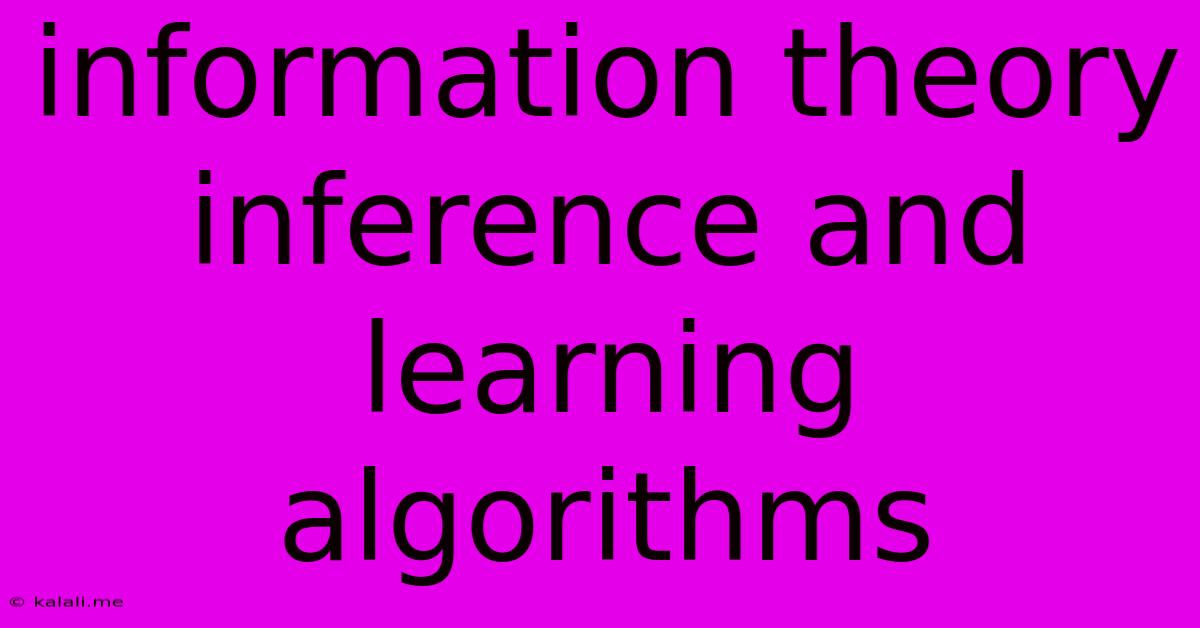Information Theory Inference And Learning Algorithms
Kalali
Jun 08, 2025 · 3 min read

Table of Contents
Information Theory, Inference, and Learning Algorithms: A Powerful Trio
Meta Description: Dive into the fascinating intersection of information theory, inference, and learning algorithms. This article explores how these fields intertwine to build powerful AI systems capable of learning from data and making informed decisions. We'll examine key concepts and their applications in modern machine learning.
Information theory, inference, and learning algorithms are not just separate fields of study; they form a powerful synergy that underpins much of modern artificial intelligence. Understanding their interplay is crucial for grasping the inner workings of many machine learning models and developing more efficient and effective AI systems. This article delves into the core concepts of each field and demonstrates how they work together to enable machines to learn from data and make informed inferences.
What is Information Theory?
At its heart, information theory quantifies information content. Instead of focusing on the meaning of information, it deals with its uncertainty. The less predictable an event, the more information it conveys. This is captured by the concept of entropy, a measure of uncertainty or randomness in a probability distribution. A high-entropy system is unpredictable, while a low-entropy system is more predictable.
Key concepts in information theory relevant to machine learning include:
- Entropy: Measures the uncertainty of a random variable.
- Mutual Information: Quantifies the shared information between two random variables. High mutual information indicates a strong relationship.
- Kullback-Leibler (KL) Divergence: Measures the difference between two probability distributions. It's used to assess how well a model approximates the true data distribution.
Inference: Making Informed Decisions Under Uncertainty
Inference is the process of drawing conclusions from available evidence. In the context of machine learning, this involves using data to estimate parameters of a model or make predictions about unseen data points. This process often involves dealing with uncertainty inherent in the data and the model itself.
Common inference techniques include:
- Bayesian Inference: Uses Bayes' theorem to update prior beliefs about parameters based on observed data. It explicitly incorporates uncertainty.
- Maximum Likelihood Estimation (MLE): Finds the parameter values that maximize the likelihood of observing the data.
- Maximum a Posteriori (MAP) Estimation: Similar to MLE, but incorporates prior knowledge about the parameters.
Learning Algorithms: The Engine of AI
Learning algorithms are the methods used to build models that can learn from data. They utilize information theory and inference techniques to improve their performance over time. The goal is to find patterns and relationships within the data that can be used to make predictions or decisions.
Different learning paradigms exist:
- Supervised Learning: The algorithm learns from labeled data, where each data point is associated with a known outcome. Examples include classification and regression.
- Unsupervised Learning: The algorithm learns from unlabeled data, identifying patterns and structures without explicit guidance. Clustering and dimensionality reduction fall under this category.
- Reinforcement Learning: The algorithm learns through trial and error by interacting with an environment and receiving rewards or penalties.
The Interplay: How It All Works Together
These three fields are deeply interconnected. Information theory provides the mathematical framework for quantifying uncertainty and measuring the information content of data. Inference methods leverage this framework to make decisions under uncertainty, estimating model parameters or predicting outcomes. Learning algorithms then use these inference techniques, guided by the principles of information theory, to learn from data and improve their performance.
For instance, in a Bayesian neural network, Bayesian inference is used to estimate the posterior distribution over the network's weights. The KL divergence might be used to measure the difference between the approximate posterior and the true posterior, guiding the learning process. The network's learning algorithm then uses this information to update its weights and improve its predictive accuracy.
Conclusion
The synergy between information theory, inference, and learning algorithms is fundamental to the success of modern machine learning. Understanding these core concepts is essential for anyone seeking to develop, improve, and apply advanced AI systems. As research continues to advance these interconnected fields, we can expect even more powerful and sophisticated AI applications to emerge in the future.
Latest Posts
Latest Posts
-
Find Text In Sql Stored Procedure
Jun 08, 2025
-
Auto Ac High Pressure On Low Side
Jun 08, 2025
-
Is Encrypted Dns An Alternative To Vpn
Jun 08, 2025
-
Can A Missing Lug Nut Cause Vibration
Jun 08, 2025
-
Find Unique Values In Array With Space Complexity 1
Jun 08, 2025
Related Post
Thank you for visiting our website which covers about Information Theory Inference And Learning Algorithms . We hope the information provided has been useful to you. Feel free to contact us if you have any questions or need further assistance. See you next time and don't miss to bookmark.